For the 1948-49 season, Paramount had complete faith in the popularity of Screen Songs. The studio was now required to deliver 12 for this season – one per month. Inside the legalese of the 1948 agreement (below – click to enlarge) is indication of a bonus to be paid to Kneitel, Sparber and Buchwald if they come in under budget. A financial incentive to make the cartoons as economical as possible. While the art qualities remain quite high on-screen, is it any wonder why so many of the stories seemed recycled from previous shorts?

Odd to see NBC radio personalities Tex and Jinx (John Reagan “Tex” McCrary and Jinx Falkenburg) plugging Famous Studio cartoons in this May 22nd 1948 trade advertisement.
Locations and themes for this season’s sing-alongs ran the gamut from Florida, Ireland, The Ozark Mountains, the farm and the ocean. The contracted twelve Screen Songs for 1948-49 became:
Readin’ Ritin’ and Rhythmatic
The Funshine State
The Emereld Isle
Comin’ Round The Mountain
The Stork Market
Spring Song
The Ski’s The Linit
Toys Will Be Toys
Farm Foolery
Our Funny Finny Friends
Marriage Wows
The Big Flame Up
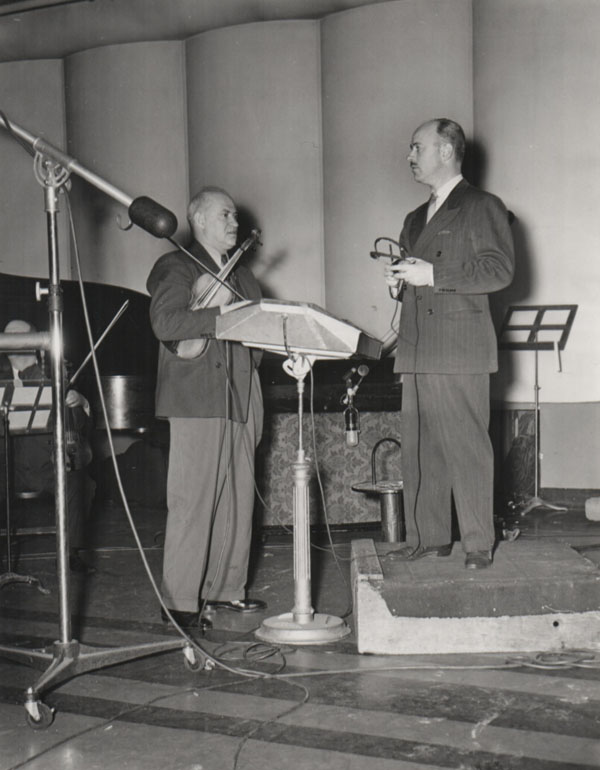
Winston Sharples (right) confers with his violinist.
Noveltoons 1948-49
The Mite Makes RiteHectore’s Hectic Life
The Old Shell Game
The Little Cut Up
Hep Cat Symphony
The Lost Dream (Little Audrey)
Little Red School Mouse
A-Haunting We Will Go (Casper)
A Mutt In A Rut
Campus Capers (Herman)
The ten Noveltoons created for the 1948-49 season stuck mainly to an assortment of original characters – with only three returning favorites (Audrey, Casper and Herman). Tytla’s “Mite” is a Tom Thumb riff, his “Hector” is a “hen-pecked” house dog, his “Campus Capers” gives Herman a chance to graduate into his series, establishing the template for years to come.
Kneitel/Tendlar’s “Old Shell Game” brings Wolfie back against a snapping turtle; their “Hep Cat Symphony” is a musical forerunner to the forthcoming Herman and Katnip scenarios – here without a “Herman” or a “Katnip”
Sparber/Waldman’s “Little Cut Up” is a musical based on the idea of a 6-year old George Washington chopping down cherry trees. Sparber/Johnson’s “Little Red School Mouse” is another cat and house opus – the well worn plot of a young mouse unaware of his adversary (a cat) but outwitting him at every turn (Teacher’s Pest (1950) and several Baby Huey entries would soon go over the same territory); Sparber/Tendlar’s “Mutt In A Rut” (featuring “Dogface”) begins as retread of Bugs Bunny’s Hare Force (1944) with a “Dog Heaven” dream sequence that may have inspired Don Bluth!
Popeye 1948-49
Snow Place Like Home
Robin Hood Winked
Symphony In Spinach
Popeye’s Premiere
Lumber Jack And Jill
Hot Air Aces
A Balmy Swami
Tar With A Star
Kneitel/Sparber and Tytla took Popeye to a variety of locales and time periods this season: The North Pole, The old west, Sherwood Forest, a Hollywood premiere and a lumber camp among others. Plots were reworked, remade or inspired by previous cartoons such as The Spinach Overture, Axe Me Another, The Hyp-nut-tist, A Dream Walking and, of course, one cartoon was a cheater – Popeye’s Premiere reusing much footage from Aladdin and His Wonderful Lamp (1939).

A model sheet for “Robin Hoodwinked”
Sales Department
The annual round up in the trades did not bode well for Famous Studios this year – with public opinion leaning towards Warner Bros. cartoons, MGM and Disney. Popeye continues to be mentioned by virtue of his star status. In fact, the more we look at it, Popeye was the raison d’être for Famous Studios existence.




ABOVE: Symphony In Spinach – note the in-joke reference to Famous Studios address at 3:40.
(Thanks Don Yowp, Will Friedwald, Thad Komorowski)



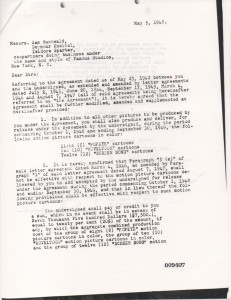

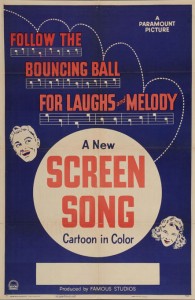
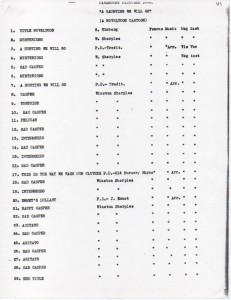
 Jerry Beck is a writer, animation producer, college professor and author of more than 15 books on animation history. He is a former studio exec with Nickelodeon Movies and Disney, and has written for The Hollywood Reporter and Variety. He has curated cartoons for DVD and Blu-ray compilations and has lent his expertise to dozens of bonus documentaries and audio commentaries on such. Beck is currently on the faculty of CalArts in Valencia, UCLA in Westwood and Woodbury University in Burbank – teaching animation history. More about Jerry Beck [
Jerry Beck is a writer, animation producer, college professor and author of more than 15 books on animation history. He is a former studio exec with Nickelodeon Movies and Disney, and has written for The Hollywood Reporter and Variety. He has curated cartoons for DVD and Blu-ray compilations and has lent his expertise to dozens of bonus documentaries and audio commentaries on such. Beck is currently on the faculty of CalArts in Valencia, UCLA in Westwood and Woodbury University in Burbank – teaching animation history. More about Jerry Beck [



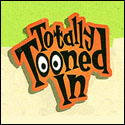



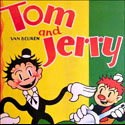
Ha, Walt Disney got showed up by Terrytoons’ Mighty Mouse. That had to sting Disney staff reading that particular trade.
Two of these I have memories thanks to old PD VHS tapes: The Big Flame Up and The Old Shell Game
I only remember “The Big Flame Up” due to how two of the fireman “die” from being roasted alive into a meat product, reminiscent of some of the earliest sound cartoons. The dog getting roasted alive seemed particularly gruesome as a kid.
“The Old Shell Game” I always found enjoyable. Despite the stupidity of the premise, the gags were fun, the short was energetic, and the animation was still appealing before Famous took very serious and noticeable budget cuts.
“I only remember “The Big Flame Up” due to how two of the fireman “die” from being roasted alive into a meat product, reminiscent of some of the earliest sound cartoons. The dog getting roasted alive seemed particularly gruesome as a kid.”
I recall footage of this cartoon, mainly the bit with the giant flame carrying a flame thrower while chasing the firemen off being used for a fast-food commercial once.
“The Old Shell Game” I always found enjoyable. Despite the stupidity of the premise, the gags were fun, the short was energetic, and the animation was still appealing before Famous took very serious and noticeable budget cuts.
Nothing says corny than to be stuck in the wrong picture!
Paramount’s Mutt in a Rut shouldn’t be confused with the Warner Bros. Elmer Fudd cartoon that came out in the 1950’s. That one was about Elmer’s dog (Rover) who watches a TV show about “Man’s Best Friend” and was convinced by the program’s host that Elmer was going to do him away – and his trying to 86 Elmer, with disastrous results for poor Rover!
Also on Popeye’s Robin Hoodwinked (not to be confused with the Tom and Jerry’s version of Robin Hoodwinked that came out in the 1950’s (featuring Lucille Bliss as the Cockney English accented Nibbles/Tuffy Mouse) – nor that crazy Hanna-Barbera version that came out around 1972 as part of ABC Saturday Superstar Movie.
The Famous cartoon was the first look of a “new and improved”(?) Olive Oyl wearing a short sleeve blouse, a black skirt, nylons and black peep Stiletto type shoes. Little John reminded me of Shorty from the late WWII Famous Studio Popeye cartoons. And Popeye’s Premiere was the last of the Popeye Arabian Night Trilogy along with Big Bad Sinbad (with footage from Popeye Meets Sindbad the Sailor) and Popeye Makes a Movie (with footage from Popeye meets Ali Baba’s Forty Thieves).
Olive’s updated design started in 1946 – predating this cartoon.
Also on Popeye’s Robin Hoodwinked (not to be confused with the Tom and Jerry’s version of Robin Hoodwinked that came out in the 1950′s (featuring Lucille Bliss as the Cockney English accented Nibbles/Tuffy Mouse) – nor that crazy Hanna-Barbera version that came out around 1972 as part of ABC Saturday Superstar Movie.
Reminded this cartoon also has the one or two odd gaffes created by the misalignment of the camera used that showed us the top pegbar in one shot, while in the next, it’s down too far in a close-up that exposes an unfinished area of Bluto in the frame. That always kills me!
Reading the blog of Kneitel’s daughter, Ruth, she notes the two of Seymour’s sons came down with polio in the late 1940s,. Being pre-occupied with that, along with needing the extra money to deal with the costs of the disease, may also have contributed to the growth in repeated, formula plots and less imaginative spot gag cartoons during this period.
The Popeye model sheet looks like Frank Endres’ work.
It doesn’t look like Endres’ works to me. My guess is that It may be been drawn by Jack Ozark. The lettering style of ‘Robinhood’ is his ( that style dating back to the 30’s) and disappears from the Johnson crew model sheets around the time he left Famous. BTW – the poses of Popeye and Bluto are redressed poses from an earlier model sheet. That happened quite a bit – another way for Famous to save money.
I don’t suppose Little John’s design was recycled from somewhere else in the studio (if that was the only original thing here).
Let’s hope Screen Songs become a Thunderbean DVD!
Don’t forget that animation blooper in Robin Hoodwinked too.
Has Warner bros nixed the POPEYE Famous Studio dvd sets for 1944-56?
The policy at Warner Bros. is to only release their classic library restored to the highest standards – and it costs thousands of dollars to remaster a single cartoon. The DVD/blu-ray business has gone from a mass medium to a collectors market, no longer making it financially feasible for a studio (with large overhead) to produce such boxed sets. So, yeah, Warner’s has nixed doing the Famous Popeye’s for the time being.
So, any shot at a Warner Archive release of the Famous cartoons? Or is WHV still holding onto those just in case it decides to change its mind?
In theory, Warner Archive can put out the Turner TV versions of the Popeye cartoons in a collection. My personal attitude is “why bother doing that? I have already recorded those off the air.”. I want restorations. However, if enough demand were sensed, that it would be profitable to release them unrestored through Warner Archive, I suppose they would do that. It’s not being contemplated or even considered at this point.
Well, Boomerang has that very annoying blue “B” bug on the corner that I’d be tickled pink to never see again. Also, despite being unrestored, they would nonetheless look better than broadcast rips and could use better prints than what is shown on TV.
I guess I’m of the opinion that full restorations are a luxury at this point in time, and in the cartoon realm only Thunderbean is doing them. Getting them out there in good transfers using quality prints is of primary concern right now.
I do not have recorded copies off the air and wouldn’t mind a Warner Archive offering for the Famous Popeyes. Heck, I’m still waiting on their second volume of the KFS Popeyes!
I have never seen Reason’ ‘Ritin’ n ‘Rhythmatic before. Is there anyway we can see it?
One of the things I find interesting about the articles regarding the leading short subjects is that it goes against some of what I’ve read elsewhere, that the Bugs Bunny cartoons were #1 starting in the mid-40s and stayed that way for many years.
Not one to criticize, but the sound on the version of SYMPHONY IN SPINACH embedded here is out of synch. In addition, the cartoon is running about a minute short. A chunk of it is missing from the middle. I found a complete copy to watch on YouTube, though. If I’d ever seen it before, I’d forgotten it.
Was Famous going for a Fleischer vibe when they made this cartoon? A number of times throughout this film, the characters speak even though their mouths aren’t moving, just as they used to in the old days.
What in the world was Polacolor? I don’t think I’ve ever seen that color process in the credits of anything other than Famous cartoons from this era.
Truly trivial department: In the first scene of the cartoon, Popeye and Bluto are reading the issue of Variety dated September 24, 1947.
I was afraid that Warner’s plans for the Famous Studios/Popeye DVD, probably already very iffy, would be dropped when Genndy Tartakovsky decided not to make his Popeye feature. I have a friend, who works for another company, who has told me it’s gotten practically impossible to interest these companies in spending the money necessary to restore, remaster and release short subjects on DVD and/or Blu-Ray. Aside from collapsing sales, the day after these things are released, they’re all over YouTube and archive.org, and too many people are content to watch a low-rez copy online rather than spending the money on a DVD or Blu-Ray. It’s our loss.
What in the world was Polacolor? I don’t think I’ve ever seen that color process in the credits of anything other than Famous cartoons from this era.
It was explained in last week’s Famous Studios column, but a short answer to it, it was a three color dye process developed by the Polaroid Corporation. It was rather short-lived as it was discontinued in ’49.
https://en.wikipedia.org/wiki/Polacolor
One additional comment I intended to post. Keep in mind that in those days, print runs were much smaller than they are now, and films–including cartoons–opened first in big cities and then worked their way down. It could take months for small towns to get them. Trade magazines usually had sections devoted to exhibitor feedback. In one of these, I remember reading a comment from one small town theater owner complaining that by the time the Screen Song cartoons reached him, the prints he received were so beat up and splicy that audiences couldn’t have followed the sing-along portion even if they were inclined to do so.
One additional comment I intended to post. Keep in mind that in those days, print runs were much smaller than they are now, and films–including cartoons–opened first in big cities and then worked their way down. It could take months for small towns to get them. Trade magazines usually had sections devoted to exhibitor feedback. In one of these, I remember reading a comment from one small town theater owner complaining that by the time the Screen Song cartoons reached him, the prints he received were so beat up and splicy that audiences couldn’t have followed the sing-along portion even if they were inclined to do so.
Sad to learn that. I wonder how lucky Toledo was during all this time, waiting for the best prints from Cleveland or Detroit to make their way over.
I think so, but we need the chance to search for the original titles from the master tapes.